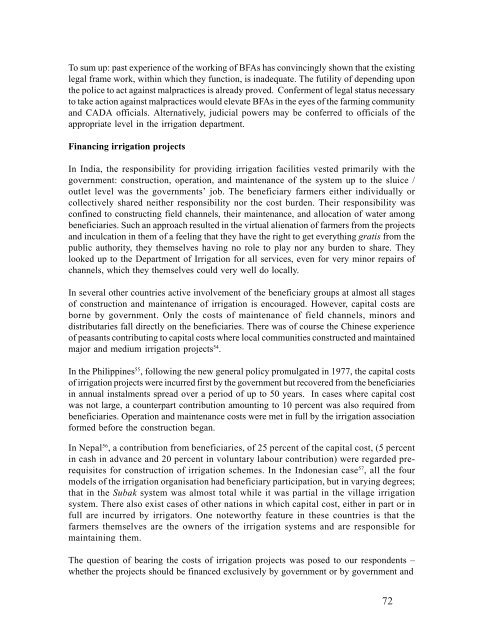Beneficiary Participation in Irrigation Water Management: The Kerala
Beneficiary Participation in Irrigation Water Management: The Kerala
Beneficiary Participation in Irrigation Water Management: The Kerala
Create successful ePaper yourself
Turn your PDF publications into a flip-book with our unique Google optimized e-Paper software.
To sum up: past experience of the work<strong>in</strong>g of BFAs has conv<strong>in</strong>c<strong>in</strong>gly shown that the exist<strong>in</strong>g<br />
legal frame work, with<strong>in</strong> which they function, is <strong>in</strong>adequate. <strong>The</strong> futility of depend<strong>in</strong>g upon<br />
the police to act aga<strong>in</strong>st malpractices is already proved. Conferment of legal status necessary<br />
to take action aga<strong>in</strong>st malpractices would elevate BFAs <strong>in</strong> the eyes of the farm<strong>in</strong>g community<br />
and CADA officials. Alternatively, judicial powers may be conferred to officials of the<br />
appropriate level <strong>in</strong> the irrigation department.<br />
F<strong>in</strong>anc<strong>in</strong>g irrigation projects<br />
In India, the responsibility for provid<strong>in</strong>g irrigation facilities vested primarily with the<br />
government: construction, operation, and ma<strong>in</strong>tenance of the system up to the sluice /<br />
outlet level was the governments’ job. <strong>The</strong> beneficiary farmers either <strong>in</strong>dividually or<br />
collectively shared neither responsibility nor the cost burden. <strong>The</strong>ir responsibility was<br />
conf<strong>in</strong>ed to construct<strong>in</strong>g field channels, their ma<strong>in</strong>tenance, and allocation of water among<br />
beneficiaries. Such an approach resulted <strong>in</strong> the virtual alienation of farmers from the projects<br />
and <strong>in</strong>culcation <strong>in</strong> them of a feel<strong>in</strong>g that they have the right to get everyth<strong>in</strong>g gratis from the<br />
public authority, they themselves hav<strong>in</strong>g no role to play nor any burden to share. <strong>The</strong>y<br />
looked up to the Department of <strong>Irrigation</strong> for all services, even for very m<strong>in</strong>or repairs of<br />
channels, which they themselves could very well do locally.<br />
In several other countries active <strong>in</strong>volvement of the beneficiary groups at almost all stages<br />
of construction and ma<strong>in</strong>tenance of irrigation is encouraged. However, capital costs are<br />
borne by government. Only the costs of ma<strong>in</strong>tenance of field channels, m<strong>in</strong>ors and<br />
distributaries fall directly on the beneficiaries. <strong>The</strong>re was of course the Ch<strong>in</strong>ese experience<br />
of peasants contribut<strong>in</strong>g to capital costs where local communities constructed and ma<strong>in</strong>ta<strong>in</strong>ed<br />
major and medium irrigation projects 54 .<br />
In the Philipp<strong>in</strong>es 55 , follow<strong>in</strong>g the new general policy promulgated <strong>in</strong> 1977, the capital costs<br />
of irrigation projects were <strong>in</strong>curred first by the government but recovered from the beneficiaries<br />
<strong>in</strong> annual <strong>in</strong>stalments spread over a period of up to 50 years. In cases where capital cost<br />
was not large, a counterpart contribution amount<strong>in</strong>g to 10 percent was also required from<br />
beneficiaries. Operation and ma<strong>in</strong>tenance costs were met <strong>in</strong> full by the irrigation association<br />
formed before the construction began.<br />
In Nepal 56 , a contribution from beneficiaries, of 25 percent of the capital cost, (5 percent<br />
<strong>in</strong> cash <strong>in</strong> advance and 20 percent <strong>in</strong> voluntary labour contribution) were regarded prerequisites<br />
for construction of irrigation schemes. In the Indonesian case 57 , all the four<br />
models of the irrigation organisation had beneficiary participation, but <strong>in</strong> vary<strong>in</strong>g degrees;<br />
that <strong>in</strong> the Subak system was almost total while it was partial <strong>in</strong> the village irrigation<br />
system. <strong>The</strong>re also exist cases of other nations <strong>in</strong> which capital cost, either <strong>in</strong> part or <strong>in</strong><br />
full are <strong>in</strong>curred by irrigators. One noteworthy feature <strong>in</strong> these countries is that the<br />
farmers themselves are the owners of the irrigation systems and are responsible for<br />
ma<strong>in</strong>ta<strong>in</strong><strong>in</strong>g them.<br />
<strong>The</strong> question of bear<strong>in</strong>g the costs of irrigation projects was posed to our respondents –<br />
whether the projects should be f<strong>in</strong>anced exclusively by government or by government and<br />
72










